Your camping trip isn’t complete without an awesome grill over the fireplace!
But if this is your first time grilling out in the wild, there are some important things you should know to keep safe and grill some awesome meat.
On our most recent trip, we were lucky enough to have a dedicated space to grill at our campsite, but I will also focus on using disposable grills—an instant grill and an eco grill.
Cooking Camping Equipment: Checklist
Make sure you have the basic equipment before you head out to grill in the great outdoors.
- Utensils. A spatula, fork, and tongs at the very least—you’ll need these to move around the meat on the grill.
- Fire starting equipment. Fire starters, a lighter, charcoal, fluid. Wood, ideally dry.
- Lights. We use caving lights. Super useful if you end up grilling late into the night and there’s little light around.
- A chopping board. Or somewhere where you can place cooked and uncooked food. It can be frustrating if you don’t have anywhere to put things.
- Cutlery. Especially a good knife if you want to cut vegetables.
- Medicines. You don’t want diarrhea while camping—there’s always a risk when grilling, especially when in the wild.
- Water. For washing veggies and your hands, for drinking, and for putting out fires.
Consider how you are getting to the camp and what that will mean for what you can pack. You can bring a lot more if you’re traveling by car or RV than with a backpack.
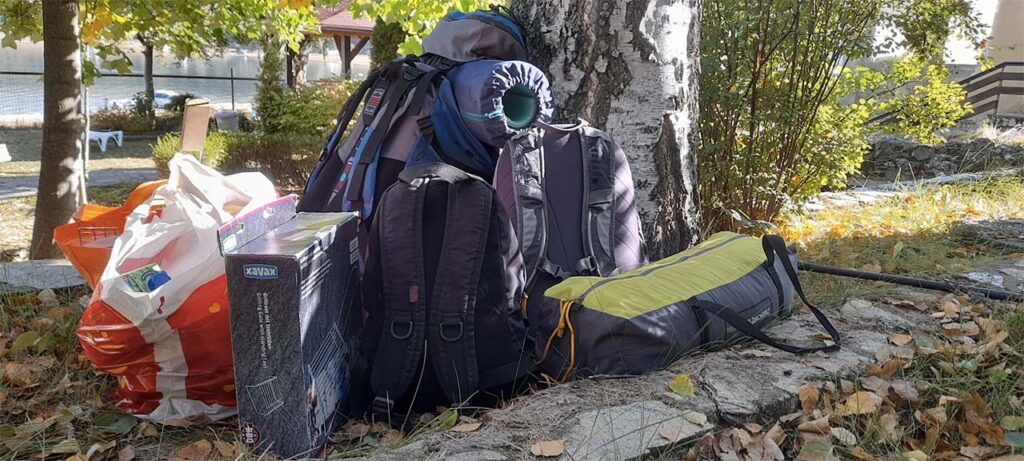
How Do You Cook on a Campfire?
There are plenty of ways to cook at a campfire but before you can even think of grilling, you’ve got to get a good fire going.
A popular but risky way (if you are inexperienced) is to use lighter fluid to set a fire, but I strongly recommend that you’re careful with this.
I have seen countless videos online of people (mostly drunk) accidentally making massive fires when they start fires this way.
Do not pour lighter fluid directly onto the fire, it will climb up the fluid and set the whole container on fire!
A spray can be safer but whatever you use, only use small amounts each time.
Remember, you only need enough to get the charcoals smoldering, you don’t need the fire to keep burning forever.
On this trip, we didn’t need any fluid and got the fire burning using a cardboard egg carton. This was something I saw on one of those cooking/grilling hack videos.
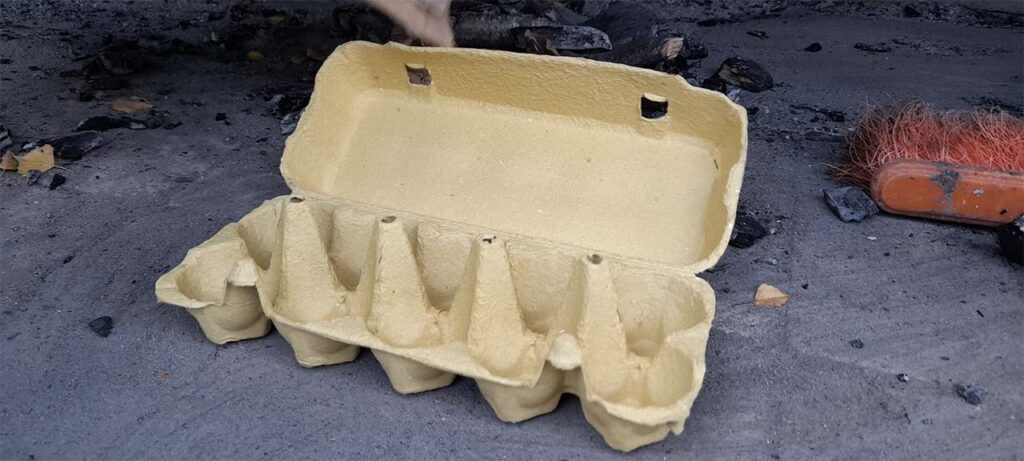
While I generally don’t take these videos that seriously, using an egg carton does work very well and I try to remember to get one before grilling in the wild.
What you do is put charcoal inside the egg carton and set the box on fire, ideally in the middle of where you want the center of the fire to be.
Burning the box helps set the charcoal on fire at just the right rate to get it smoldering. Putting charcoal around the box is also helpful to expand the fire outwards.
Notes on using paper: Using paper to start fires is a great way to recycle old documents or papers you don’t need.
Paper will not be enough to keep the fire going long enough for grilling if that is the only thing you have.
Don’t use paper with a plastic lining, you want to use normal paper. Fancy printing paper doesn’t burn well. (It may also smell funny.)
And more importantly, you don’t want to smother the fire. Paper burns very quickly and leaves a lot of ash which can then prevent the fire from growing.
As I remember from high school, fire needs three things 1) heat, 2) oxygen, and 3) fuel. Too much ash will make it harder for the oxygen to reach the flames.
The best way to use paper is to place it at the bottom of the fireplace, under the charcoal or wood you plan to burn, and then set it alight.
Burning from the bottom and not the top will allow the fire to spread upwards into the fireplace and not cover it with ash. Remember, heat travels upwards.

Make a pile combined with your flammable materials. We used charcoal and wood (and a cardboard egg carton).
As the charcoal begins to smolder, slowly break down and spread the charcoal and wood.
Do not break it apart too quickly or while it’s flaming because you could lose a lot of heat and put out the fire.
Lastly, avoid using damp wood as it takes longer to burn. Dry wood is ideal.
How Do You Safely Cook Over a Fire?
First and foremost, make sure you can set a fire. Ask the campsite manager or if you’re camping in the wild, make sure it’s legal.
Not only do you not want to break the law, but you also probably don’t want to start a forest fire either.
The safest way to cook over a fire is using a grate. You can grill on the grate. It’s strong and likely won’t break
Tongs, forks, and skewers are potential alternatives if you don’t have a grate, but be careful, your arms can get tired.
Keep what you’re cooking far enough from the flames. The aim is to cook it, not set it alight.
Don’t crack open a beer immediately, get the fire sorted first.
Don’t risk any accidents grilling drunk. It’s probably best to save cracking open a beer until the meat is on the grill or, best case, already cooked.
How Far Away From Your Tent Should You Cook?
Ensure a safe distance of at least 10 feet (3 meters) from your tent to your fire when camping.
Take note of any supporting ropes for your tent too—they should also be kept away from the fire.
Make sure the fire won’t spread. Do not make a fire too close to trees that could set alight and remove any flammable material from the area.
Keep your cooking materials nearby to the flames—not by the tent. Make grilling convenient which will make it safer.
Also bear in mind the possibility that how your position your tent and the fire can impact how the heat spreads.
For example, a cliff or a wall could trap heat and send it toward your tent. In such cases, it will likely be better to position the tent further than 10 feet from the fire.
Wherever to set up your fire and tent, you shouldn’t be able to feel the strength of the flames on your tent.
Should Charcoal Be on Fire When Grilling?
There should not be flames rising from the charcoal when grilling. The flames should die down and there should be a white and red glow from the charcoal.
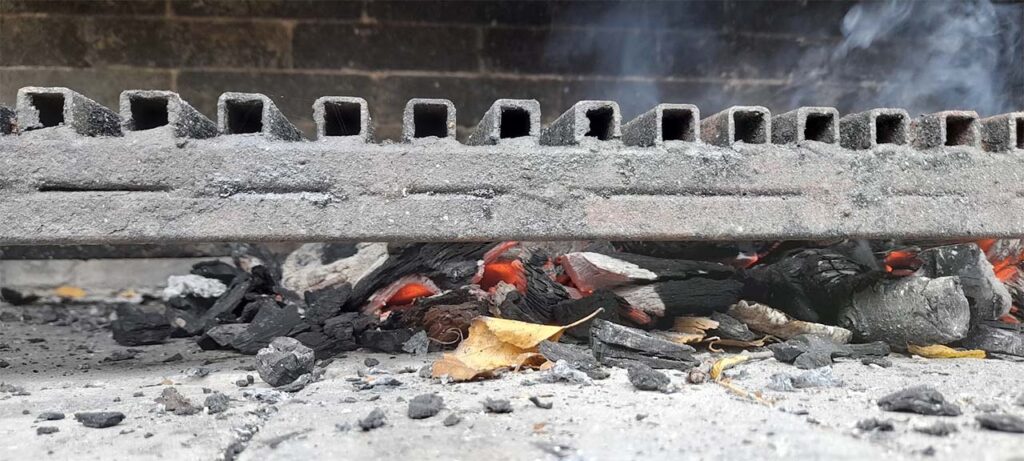
The charcoal will take a moment for it to reach this point, so be patient.
Don’t put the meat on the grill when the fire is still flaming. Fire can go out and then you’ll have to start it all over again.
Using a Campfire Cooking Grate
If it’s a communal grill at a managed campsite, you may want to clean it up a bit. (If no one did before you.)

Get the fire going before putting the grate. The fire should be spread out so it’s not higher than the grill’s legs.
And if the charcoal is evenly spread under the grill, you will be able to make the most use of all the space available.
As the grate heats up, can use a grill brush to clean off any leftover gunk from previous cooks.
A common way to clean a grill grate is with onion. When the grate is hot, cut an onion in half and using a fork rub it against the metal.
We also experimented with using a portable cooking grate.
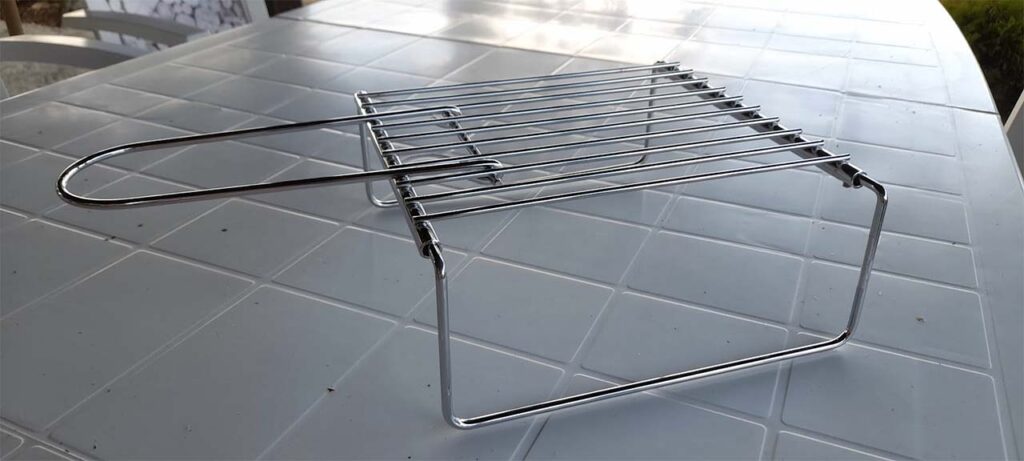
Relatively inexpensive, it can be adjusted to be longer, though the grill part doesn’t extend so I likely will not make use of that feature.
The portable grate provided 3.9 inches (10 cm) of height. I used bricks to raise it more, but you can also place it directly on the fire if you need to.
In the end, the portable grate was highly effective for a small fire. But to grill larger meals will likely mean refueling the fire frequently and will take longer.
What Is the Best Portable Grill for Camping?
Whenever I’m grilling in the wild or somewhere where I don’t know if there will be a grill available to use, I bring a backup instant grill.
They usually come in a cardboard box with a metal tray and a grate. Inside the tray is a flammable bag with charcoal.
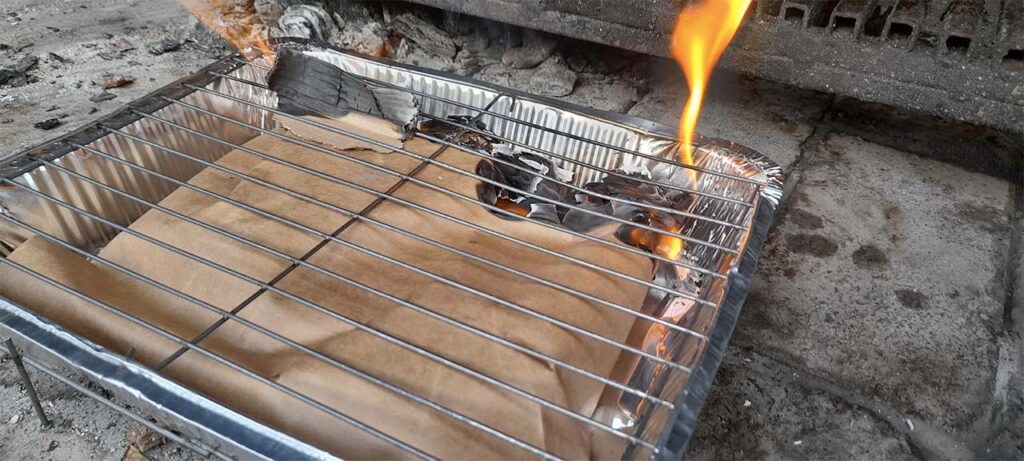
Instant grills are quite easy to start. All you need to do is set the bag on fire and it’ll light the charcoal.

Usually, you’ll get a stand to put under the grill—make sure you place the instant grill on top before starting the fire.
Also, make sure the ground is flat before placing the grill. You can use a patio slab or something else strong and flat if the ground is bumpy around you.
This time, we used a different brand, and it was a huge disappointment for two big reasons:
- There were no holes in the bottom of the box which meant air couldn’t get to the fire, and it made setting the flammable paper harder.
- The paper was thick and burned poorly.
Unable to get it started, we decided to give up on this one. But it’s not all bad news—for this camping trip, we finally got a chance to try out an eco grill.
It’s circular, made of wood with an outer ring for charcoal and a fire starter in the middle.
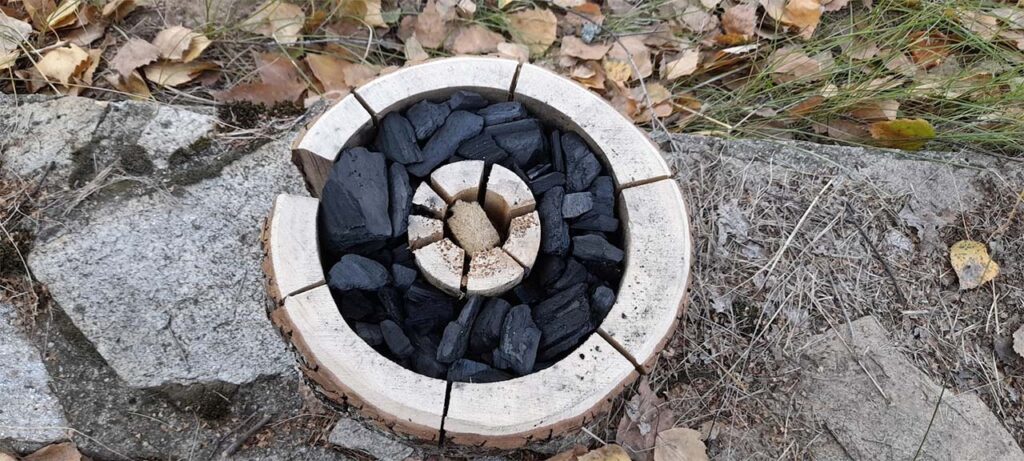
When finished, it leaves nothing but ash—the only waste was the plastic packaging it came in. Definitely more environmentally friendly than an instant grill.
You get the fire started by setting the fire starter and it spreads to the wood and charcoal.
Opening it, I noticed what appeared to be a piece of wood missing, but this is likely to allow air in, and indeed the fire grew in that direction.
I would recommend being ready to start grilling when using an eco grill as they burn very quickly.
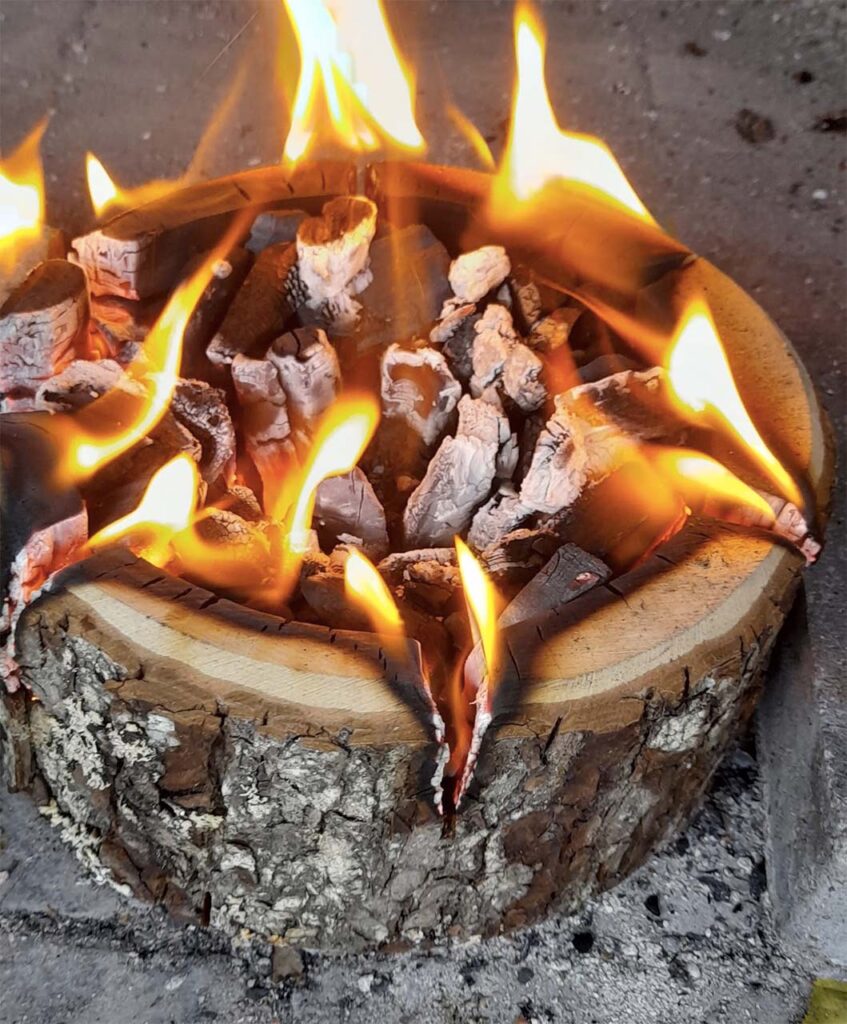
Also, note that the entire eco grill will burn up. So, it should be placed somewhere where it won’t ruin the ground and can be controlled.
Because of the way the entire grill lights up, eco grills could be used to make a larger fire if you have more charcoal and wood to add to it.
Not only is the eco grill better for the environment, but it’s also more practical as you don’t need to take any waste with you when finished.
How to Cool Down a Grill Quickly?
The fastest way to cool down a grill is with water but distance yourself from the grill. Don’t put your face directly over the fire as it can burn your face with steam.
If the fire is on the ground, you can cover it with dirt which can smother the flames and put it out. Likewise, if there is a lot of ash left over from previous grills, that can also work.
Well-kept campsites should have fire extinguishers around to quickly put out fires if they get out of hand.
Can You Grill Under a Tent?
I would recommend not grilling under your tent unless it is at least 8 feet (2.4 meters) with a high ceiling, plenty of ventilation, and bottomless.
though it does depend on the height of the roof from the grill and the size of the fire.
Find out what material the tent is made from. Most are made from either nylon or polyester which while they do not ignite, can melt.
And this melted material can cause burns and even if you’re safe, you could risk completely ruining your tent with a new window.

If you’re not experienced at grilling, I would strongly advise not starting a fire within your tent. Most modern tents are not designed for people to grill inside.
Direct and Indirect Grilling
Now here’s some super important advice for those who are grilling in the wild for the first time.
There’s a super important difference between grilling directly on the fire and indirectly.
You may be forgiven for thinking that you must always grill directly on the fire.

Grilling directly is good for creating a great sear, and it will cook the outside much quicker, but it may fail to cook the inside enough.
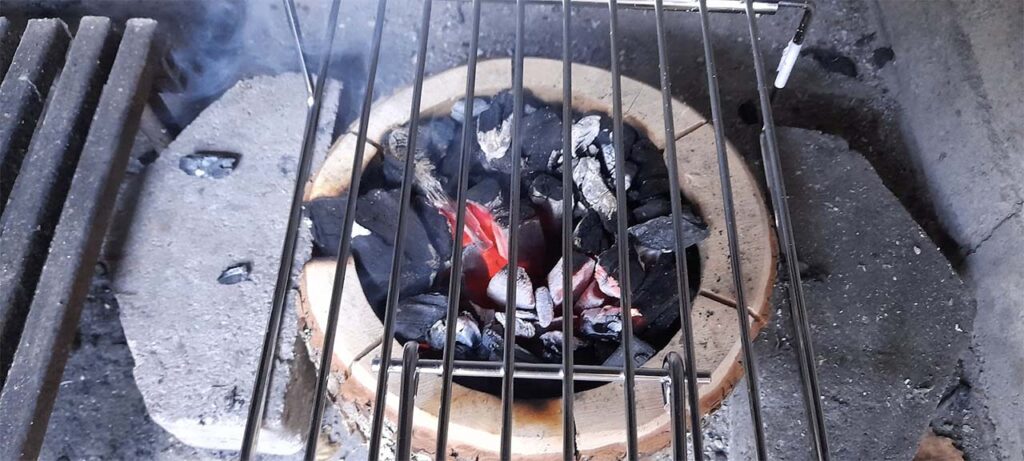
Grilling indirectly takes longer but will give the heat more time to reach the interior of the meat.
Combine direct and indirect grilling to make sure the inside is properly cooked and the exterior crunchy.
How to Eat Healthy While Camping?
Bring fruit and vegetables that are not vulnerable to getting squished. Dried fruits, seeds, and nuts also make great healthy snacks.
Remember to bring enough water to stay hydrated, especially if you’re camping somewhere hot and if you’re drinking alcohol.
If you have the space, take an ice box for your meats to keep them cool.
Keep in mind that it is not recommended for most foods to spend more than two hours at room temperature.
This is where bacteria multiply at their fastest rate.
What’s the Best Way to Make Coffee When Camping?
The best way to make coffee when camping is right on the fireplace.
We took a coffee percolator. Though often considered slightly bitter than other coffee brewing methods, it’s my favorite.

It’s very easy to use—water goes in the bottom, coffee in the middle. Place the percolator on top of the grill and wait until you have coffee.
I will say that making coffee on the grill is different from at home where you may have more control over the heat. A percolator may work much faster.
Be careful not to melt the handle!
What’s the Best Way to Cook Toast When Camping?
We also make toast on the grill. Be careful trying to toast bread over an open fire as you may just set the bread on fire.
You will need to flip your toast to get both sides nice and crunchy.
We also do this with burger buns, though it is more important to get the inside crunchy than the outside.
Usually, making toast is at the last stage of grilling, when the meat and vegetables are all cooked.
What to Do With a Grill When Done?
What you do with a grill depends entirely on what you plan to do next. Do you plan on using it for heat at night or will you use it again in the morning?
If you need it at night, you’ll want to keep it on, but do be aware, it can draw in animals which can be dangerous.
if you are not worried about anyone getting hurt, you can let it die down naturally and enjoy it for a while.
But if you think it’s more responsible to put it out, the most obvious option is to use water.
If you want to use it again in the morning, while you can put the fire out, if you use water, don’t put so much that the grill will be unusable
If you used an instant grill, make sure you dispose of it properly. Not just to be pleasant to the next people to use that space, but for your safety.
Before moving it, check that it’s not alight and not hot. Note that in hot climates it will take longer for it to cool down.

